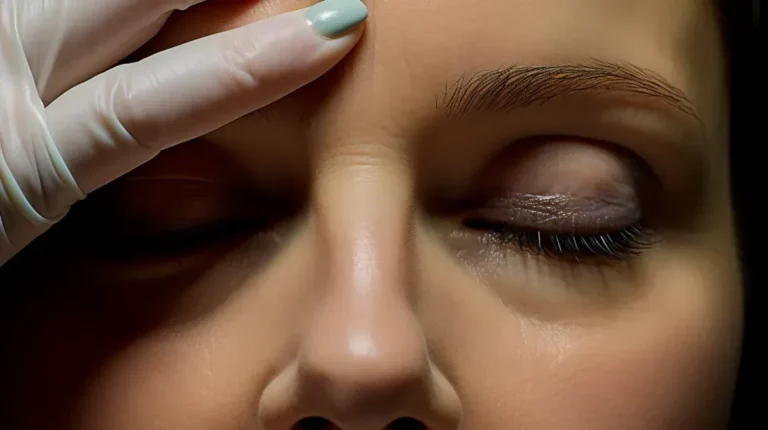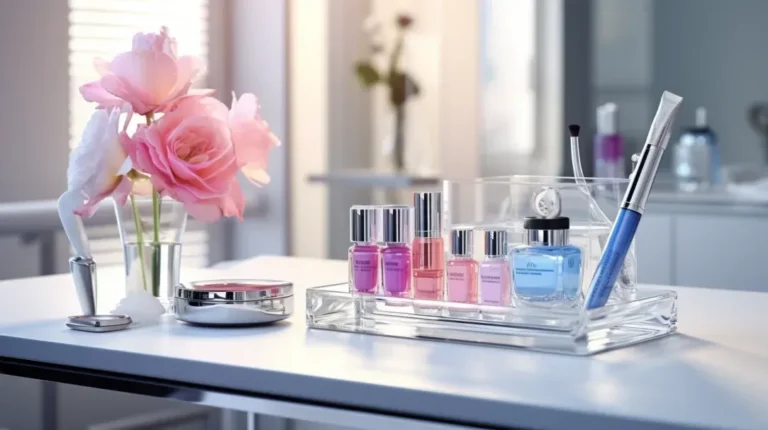Reactions to Botox: What to Expect
Are you thinking about getting Botox? What kind of botox reactions do you experience? Look no further. This article will walk you through the typical physical responses, recovery time, and how to handle rare but severe reactions to Botox.
We’ll compare patient stories with clinical data and explore the latest improvements in Botox formulations to reduce side effects. With a focus on safety and education, we’ll provide you with all the information you need to make informed decisions about your Botox journey.
Key Takeaways
- Typical physical reactions to Botox include bruising, swelling, and redness at the injection site.
- The timeline for recovery and normalization post-treatment varies, but most patients can expect to see results within a week and full effects within two weeks.
- Rare but severe reactions to Botox can occur, such as allergic reactions or muscle weakness. These reactions are managed by seeking immediate medical attention and discontinuing further treatment.
- Patient experiences and expectations may vary, but clinical data shows that Botox is generally safe and effective when administered by qualified healthcare providers.
Common Botox Reactions
When undergoing Botox treatments, it’s essential to be aware of the common reactions that your body might experience. While Botox is widely used for cosmetic and medical purposes, it can cause several mild and typically short-lived side effects.
Common Side Effects of Botox
- Swelling and Bruising: One of the most frequent reactions to Botox injections is swelling and bruising at the injection site. This is a natural response as the body reacts to the needle and the injected substance.
- Redness: Redness around the injection site is also common, along with swelling and bruising. These symptoms are typically mild and should resolve relatively quickly, usually within a few days to a week.
- Individual Variations: It’s crucial to remember that reactions to Botox can vary from person to person. Factors such as skin sensitivity, injection technique, and individual healing processes can influence the nature and duration of these reactions.
Minimizing Reactions and Aftercare
- Avoiding Aggravation: To help minimize reactions, avoiding touching or rubbing the treated area post-injection is advised. This precaution helps prevent further irritation or spreading of the Botox to unintended areas.
- Using Ice Packs or Cold Compresses: Applying ice packs or cold compresses as directed by your healthcare provider can help reduce swelling and discomfort.
- Following Aftercare Instructions: Adhering to the aftercare instructions provided by your healthcare provider is crucial for a smooth recovery and optimal results from Botox treatment.
When to Seek Medical Advice
- Monitoring Reactions: While common reactions to Botox are generally mild, it’s essential to monitor them. If the reactions worsen or persist beyond the typical timeframe, it’s crucial to contact your healthcare provider.
- Safety and Comfort: The transient nature of these reactions usually means they won’t cause long-term discomfort. However, seeking medical advice when in doubt ensures your safety and peace of mind.
Being informed about these common reactions and how to manage them effectively can help ensure a more comfortable and successful Botox treatment experience.
Managing Botox Side Effects

When undergoing Botox treatments, being proactive in managing potential side effects is crucial for a smooth recovery and optimal results. Understanding and following the appropriate aftercare measures can significantly reduce the risk of complications and discomfort.
Essential Aftercare Guidelines for Botox
- Avoiding Strenuous Activities: Refraining from strenuous physical activities for at least 24 hours post-treatment is advised. This precaution helps to minimize the risk of increasing blood flow to the injection sites, which can exacerbate swelling or bruising.
- Refraining from Touching or Massaging: Avoid touching, rubbing, or massaging the treated areas. This is important to prevent spreading the Botox to unintended muscles and areas, which could lead to unwanted effects.
- Maintaining Cleanliness and Moisture: Keeping the injection sites clean and moisturized is essential. However, be gentle and use mild skincare products to avoid irritation.
Recognizing and Responding to Common Reactions
- Injection Site Reactions: Be aware that redness, swelling, and bruising at the injection sites are common reactions. These typically resolve on their own within a few days. Applying cold compresses can help alleviate these symptoms.
Awareness of Rare Allergic Reactions
- Identifying Allergic Reactions: Though rare, allergic reactions to Botox can occur. Symptoms like difficulty breathing, hives, or facial and throat swelling are severe and require immediate medical attention.
- Seeking Emergency Care: If you experience any signs of an allergic reaction, it’s crucial to seek medical help immediately. Please do not wait for the symptoms to resolve on their own.
By adhering to these aftercare guidelines and being vigilant about potential side effects, you can effectively manage your Botox treatment experience. Remember, while most side effects are mild and transient, consult your healthcare provider if you have any concerns or unusual symptoms post-treatment.
Recovery and Normalization Timeline
When it comes to recovery after Botox treatment, the duration can vary from person to person. Generally, any initial swelling or bruising takes 24 to 48 hours to subside.
However, it may take up to two weeks for the full effects of the treatment to be visible and for the results to normalize. The individual healing ability, injection technique, and the specific areas treated can influence the recovery timeline.
Recovery Duration After Botox
The recovery duration after Botox treatment varies for each individual. While most people experience mild reactions to Botox, it’s essential to be aware of possible complications.
Here are some key points to keep in mind:
- Botox recovery tips: Following your dermatologist’s aftercare instructions can help minimize discomfort and promote healing.
- Mild reactions to Botox: Bruising, swelling, and redness at the injection site are common but typically resolve within a few days.
- Recovery duration after Botox: It can take up to two weeks for the full effects to be visible and for any initial side effects to subside.
Everyone’s experience may differ, and if you have any concerns or unusual symptoms, it’s crucial to reach out to your healthcare provider.
Stay informed and take care of yourself during the recovery process.
Factors Affecting Recovery
As you recover from your Botox treatment, various factors can influence the timeline for normalization and the overall recovery process. Understanding these factors can help you navigate your recovery journey with confidence.
Botox Safety: Ensuring the treatment was performed by a qualified healthcare provider and adhering to FDA regulations plays a crucial role in a smooth recovery.
Botox Follow-up: Following up with your healthcare provider after the treatment allows them to assess your progress, address concerns, and guide optimal recovery.
Adverse Reaction Management: If you experience unusual or severe reactions, seeking immediate medical attention is essential. Your healthcare provider can guide you through appropriate management strategies.
Rare but Serious Reactions and Management
In the realm of Botox treatments, while most side effects are mild and manageable, it’s vital to be aware of and responsive to any severe but rare reactions that might occur. Understanding the signs of these reactions and knowing when to seek medical assistance can be crucial for your health and safety.
Recognizing Serious Side Effects of Botox
- Neurological Symptoms: Be vigilant for symptoms such as difficulty breathing, swallowing, or speaking. These could indicate serious complications related to the nervous system.
- Muscle Weakness: Unusual muscle weakness, especially sudden or severe, can be concerning.
- Vision Changes: Any sudden changes in vision post-Botox treatment should be considered severe and warrant immediate medical attention.
Immediate Steps to Take
- Seeking Urgent Medical Help: If you experience any of the above symptoms after receiving Botox injections, seeking immediate medical assistance is imperative. These symptoms could escalate quickly and require prompt attention.
- Informing Your Healthcare Provider: It’s essential to inform your healthcare provider about adverse reactions. This information is crucial for them to assess your condition accurately and provide the necessary treatment.
- Managing Complications: Your healthcare provider will guide you through managing these complications, which may involve medical interventions and close monitoring of your condition.
Safety and Well-Being
- Prioritizing Health: Always prioritize your health and well-being. If you’re unsure or concerned about symptoms post-Botox, it’s better to err on the side of caution and consult a healthcare professional.
- Awareness and Education: Being educated about the potential risks and knowing how to respond to them can make a significant difference in the safety and success of your Botox treatment.
As we move forward, exploring the comparison between patient experiences and clinical data regarding Botox will provide a broader perspective on its effects and effectiveness. This comparison can help you decide whether Botox is right for you.
Patient Experiences Vs. Clinical Data
When considering the effects of Botox, it’s essential to compare patient experiences with clinical data. While clinical trials provide valuable information on safety and efficacy, individual experiences can vary.
Patient satisfaction and expectations play a significant role in evaluating the overall benefits of Botox.
Comparing Experiences Vs. Data
When comparing experiences with Botox to clinical data, it’s essential to consider both patient testimonials and scientific research. While patient experiences can provide valuable insight into Botox treatment’s potential side effects and outcomes, clinical data offers a more comprehensive and evidence-based understanding.
Here are some key points to consider:
- Botox consultation advice: It’s crucial to consult with a qualified dermatologist who can assess your individual needs and medical history before proceeding with Botox treatment.
- Long-term effects of Botox: Scientific studies have shown that the effects of Botox can last for several months, but more research is needed to determine the long-term effects.
- Preventing Botox side effects: Following post-treatment care instructions and avoiding certain activities, such as vigorous exercise, can help minimize potential side effects.
- Botox treatment guidelines: Healthcare providers follow specific guidelines for Botox administration, including recommended dosage and injection techniques, to ensure safe and effective outcomes.
Patient Satisfaction Vs. Clinical Trials
Comparing patient satisfaction with clinical trial data provides valuable insights to gauge the effectiveness of Botox treatment. Patient satisfaction is a crucial indicator of treatment success, reflecting the real-world experiences and outcomes of individuals who have undergone Botox injections. Clinical trials, on the other hand, provide controlled and standardized data that can help evaluate the safety and efficacy of botulinum toxin type A and different injection techniques. By examining both patient satisfaction and clinical trial data, a more comprehensive understanding of the benefits and limitations of Botox treatment can be obtained. Here is a table summarizing the key points:
| Patient Satisfaction | Clinical Trials |
|---|---|
| Reflects real-world experiences | Controlled and standardized data |
| Provides insights into treatment outcomes | Evaluates safety and efficacy |
| Varied individual experiences | Consistent results across participants |
Advances in Botox Formulations
The field of cosmetic dermatology and treatments has seen notable advancements in Botox formulations and injection techniques, enhancing both the efficacy and safety of these treatments. These developments offer improved patient outcomes and contribute to the growing sophistication in the application of Botox for various purposes.
Enhanced Injection Techniques
- Precision and Targeting: Modern injection techniques have become more refined, allowing practitioners to administer Botox with greater precision. This improvement leads to more accurate targeting of specific muscles and areas, enhancing the effectiveness of the treatment while minimizing the risk of spreading to unintended areas.
- Reduced Adverse Reactions: With more precise techniques, there’s a lower risk of adverse reactions. This precision ensures that Botox affects only the intended muscles, reducing the likelihood of side effects such as drooping or asymmetry.
Longer-Lasting Formulations
- Extended Duration of Action: Recent advances in Botox formulations have led to treatments that offer more prolonged effects. This means patients can enjoy the benefits of their Botox treatment for a more extended period before needing a follow-up session.
- Greater Convenience and Satisfaction: Longer-lasting effects provide greater convenience and satisfaction for patients, reducing the frequency of treatments needed to maintain the desired results.
Consistency and Predictability in Results
- Improved Formulations: The consistency and predictability of Botox effects have been enhanced due to advancements in the formulation process. These improvements ensure that patients achieve more consistent and predictable treatment outcomes.
- Tailored Treatments: The ability to predict results more accurately allows practitioners to tailor treatments to individual needs more effectively, ensuring that each patient receives the most appropriate and effective dosage and application.
These advancements in Botox formulations and techniques represent significant strides in the field, offering patients safer, more effective, and longer-lasting results. As the technology and understanding of Botox continue to evolve, we can expect further improvements and refinements in these treatments.
Essential Advice for Managing Reactions
Allergic reactions can manifest in various ways, from neck pain to double vision and even flu-like symptoms. Various factors, including medical conditions or urinary tract infections, can trigger these reactions. Some individuals may experience droopy eyelids or seek cosmetic procedures like dermal fillers, but it’s essential to be aware of potential side effects.
Muscle weakness and stiffness may also occur, and for those on blood thinners, it’s crucial to monitor for any adverse reactions. Additionally, respiratory tract infections or overactive bladder issues can exacerbate symptoms. If you experience any unusual symptoms or side effects, it’s advisable to consult with a medical professional to address and manage these concerns effectively.
- To effectively manage reactions to Botox, follow these critical pieces of advice.
- First and foremost, schedule a consultation with a qualified dermatologist before undergoing the treatment. They’ll assess your health history and discuss potential risks or complications.
- During the procedure, your dermatologist will carefully inject Botox into specific facial muscles to target wrinkles and lines.
- It’s important to note that Botox isn’t a permanent solution, and the effects typically last for a few months. To maintain optimal results, following a skincare routine post-Botox routine that includes gentle cleansing, moisturizing, and sun protection is recommended.
- The frequency of Botox treatments varies depending on individual factors and desired outcomes, so consult your dermatologist for personalized guidance.
Frequently Asked Questions
Can Botox Cause Any Long-Term Effects or Complications?
Botox can cause long-term effects or complications. It is important to note that serious complications are rare, but they can include muscle weakness, drooping eyelids, or an allergic reaction.
What Should I Do if I Experience an Allergic Reaction to Botox?
If you experience an allergic reaction to Botox, seek medical attention immediately. Common symptoms include swelling, itching, and difficulty breathing. Remember, consulting with a healthcare professional for proper diagnosis and treatment is essential.
Are There Any Specific Guidelines for Botox Treatment in Different Areas of the Face?
Specific guidelines exist for Botox treatment in different areas of the face. These guidelines help ensure safe and effective results. Your healthcare provider will determine the appropriate dosage and injection techniques based on your needs.
How Often Should I Receive Botox Treatments for Optimal Results?
You should receive Botox treatments every 3 to 4 months for optimal results. This allows for consistent muscle relaxation and helps maintain the desired effect. Consult with your provider for a personalized treatment plan.
Are There Any Specific Skincare Routines or Post-Treatment Care I Should Follow After Getting Botox?
After getting Botox, it’s essential to follow a post-treatment care routine. This may include avoiding strenuous activities, not touching the injection sites, and moisturizing your skin.
Conclusion
In conclusion, understanding the potential reactions to Botox is essential for anyone considering the procedure. While most side effects are mild and temporary, it’s essential to know how to manage the rare but severe reactions.
Clinical data shows that advancements in Botox formulations have led to a reduction in adverse effects. Interestingly, research indicates that over 95% of patients report satisfaction with their Botox experience.
You can confidently embark on your Botox journey with the proper knowledge and guidance.







